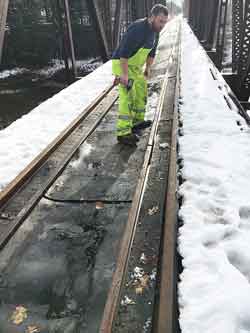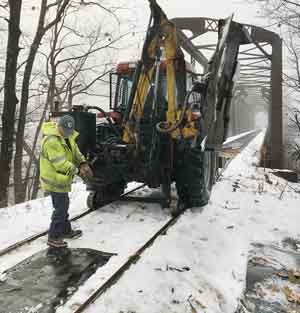Railroad Corridor
Ever wonder what it takes to have a railroad corridor, with tracks still in place, ready for the snowmobile season (for those lines that allow winter use by snowmobiles that is)?
Let’s start with the basics first: it is illegal to ride a snowmobile on an active railroad! End of story. NH has several year-round active railroads and at no point in time is snowmobile use along these railroad lines legal.
There are a few rail lines, however, that do not operate in the winter and we are permitted to use portions of these lines as snowmobile trails. These railroad lines technically close for rail use in the winter months and are given over to the Trails Bureau to use as a trail for a limited period of time.
The most notable is the Concord-Lincoln Corridor. This line follows I-93 for from Exit 18 in Canterbury through Laconia and Meredith and back to I-93 north to Lincoln. It is open for snowmobile use typically after January 1 until mid-March.

Railroad corridors are not ideal trails, as the rail is still in place and it takes 2-3 times as much snow to make these ready for riding as a gravel road/trail. But they are general uninterrupted routes across portions of the state and without them we would have difficulty getting trails across some of the bigger rivers.
These corridors take a lot of work to be ready for a short period of time. All of thetrestlebridges have to have rubber belting put down between the rails and this is time consuming and a little tricky. The belting serves to hold snow on the bridges and also to protect the railroad bridge ties from damage from skis and tracks.
Each 50’ section of belting weighs several hundred pounds and has to be pulled onto the bridge by something mechanical (ATV, tractor, etc). The bridge is often icy or snowy when we are told we can put the belting out and most of the trestles are 30-40’ above the river.
Next time you are riding on one of these railroad lines (look for the signs designating it as a legal trail) don’t just zip along thinking nothing about it. These ‘trails’ take a lot of work, by a very limited number of staff and volunteers to be ready to use. And all of that work has to be undone bythe second week in April so trains can take them over again.
Meeting A Groomer
When you meet a vehicle that is 10x larger and heavier than you are, what do you do? Yield. There were a few instances of a rider striking a groomer last season and there was already another this December, the day before the trails actually opened! Groomers should be expected on a trail at any time of day or night.
Most trail width is determined by the width of the grooming tractor. What does that mean? It means that the groomer likely takes up the ENTIRE trail width. This means that groomers operate on the right, left, and middle of a trail.

The groomer is moving at about 6-8 mph, has flashing or rotating lights on it, and is not camouflaged (usually red, orange, yellow or silver). On trails that are wider than a groomer (Coos County) you might find two groomers working in tandem on a section of heavily used trail. No different than two DOT trucks plowing I-93 in a storm.
It is fair to say that without some extremely extenuating circumstance, if you run into a groomer it is your fault. These machines and their operators are out there to improve trails for your enjoyment. Let them do their work and give them the room to do it.
Backcountry Riding Update
The most popular sleds for riders to buy today are backcountry/mountain/crossover sleds. These sleds were designed for riding out west in deeper snow, but they have become very popular to eastern riders to buy and ride also.
One issue for these sleds is that the taller paddle tracks have some difficulty cooling the motor on hard-packed or icy trails. As such, many of the riders on these sleds look to get off of the designated trail and into some loose snow to cool the motor. This has led to landowners threatening to close trails because riders are not staying on the trail that was established many years ago.
One of the most popular places to try to get a “back country” experience is north of Rte. 26 in Coos County. The Connecticut Lakes Headwaters has several areas that are ideal for this style of riding and a group has formed to try to get some areas open to this “off-trail” riding. The Bureau met with several landowners to discuss this concept and a few things came up that no one had thought about in previous discussions.

The Connecticut Lakes Headwaters cannot be opened for off-trail riding in any locations. The landowner of the property does not have the right to allow this use. In 2001 the State of NH purchased a conservation easement on the property. The road network became property of the State and a vast network of “designated snowmobile trails” was documented and included in the easement.
Snowmobiling is the most protected recreational activity on the property. However, in 2001, the idea of having legal riding off-trail was not even a consideration and the easement was written to specifically protect the long-standing tradition of riding on trails only.
Even the landowner of the property does not have the rights to give written permission for riders to go off trail. It is important to note that the landowner has asked law enforcement officials to stop all off-trail riding on this property.
The Bureau also met with several other large landowners in the North Country to see what their thoughts were on designating some free-riding areas on their properties. There is some general support for this in the future, but we still have to work out a few things: how do we define the boundaries (likely will find an area that has trails on all sides and highlight the area within those trails); and does the Bureau’s landowner liability Insurance policy still protect the landowner for this activity? The insurance policy has always been written to protect landowners for use of a designated trail, not for riding anywhere on the property without boundaries. This question is still out to our insurance provider to try to get an answer back.
In summary, it is not legal to ride a snowmobile off of a designated trail in NH unless the rider has written permission from the landowner. And most landowners are not going to give that permission at this time. Technology moves faster than policy and tradition. We are continuing to work on this, but no guarantee we will have any solutions for this season.

You must be logged in to post a comment.